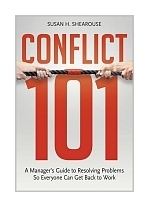We all know conflict is unavoidable…especially in the workplace. Whether
it’s a fight over resources, a disagreement about how to get things done, or an argument
stemming from perceived differences in identities or values, it’s a manager’s role to
navigate relationships, and build compromises and collaborations.
Conflict 101 gives readers the tools they need to ensure not only that
employees get back on track, but that disagreements breed positive results.
Readers will learn how to:
• Build trust
• Harness negative emotions
• Encourage apologies and forgiveness
• Use a solution-seeking approach
• Say what needs to be said
Incorporating anecdotes taken from the author’s twenty years of experience as a
conflict resolution professional, the book helps readers more deeply understand how
conflict is created, how to respond to it, and how to manage it more effectively.
Table of Contents
ACKNOWLEDGMENTS
PART I
INTRODUCTION
CHAPTER 1 THE JOY OF CONFLICT
Conflict Defined
Conflict in the Workplace
Drawing from My Own Experience
How We Think About Conflict
Overview of the Book
CHAPTER 2 WHAT GETS IN OUR WAY?
Fear as a Stumbling Block
Blame as a Stumbling Block
Assumptions as Stumbling Blocks
Habits as Stumbling Blocks
PART II
UNDERSTANDING THE DYNAMICS OF CONFLICT
CHAPTER 3 WHAT WE NEED: THE SATISFACTION TRIANGLE
Substance Satisfaction
Process Satisfaction
Emotional Satisfation
CHAPTER 4 WHERE WE ARE: LEVELS OF CONFLICT
The Five Levels of Conflict
Strategies for Each Conflict Level
CHAPTER 5 HOW WE RESPOND: APPROACHES TO CONFLICT
Avoiding
Accommodating
Directing
Compromising
Collaborating
CHAPTER 6 WHO WE ARE: CULTURAL CONSIDERATIONS
Culture Defined
Five Dimensions of Cultural Difference
Power and Culture
CHAPTER 7 WHAT WE ARE ARGUING ABOUT MATTERS: SOURCES OF CONFLICT
Information
Interests
Structural Conflicts
Values
Relationships
PART III
KEYS TO RESOLVING CONFLICT
CHAPTER 8 BUILDING TRUST
Components of Trust
How to Wreck Trust
How to Build Trust
How to Rebuild Trust
CHAPTER 9 APOLOGY AND FORGIVENESS
Apology Offered
Forgiveness Granted
CHAPTER 10 RETHINKING ANGER
The Physiology of Emotions
How to Manage Your Own Anger
How to Respond to Someone Else’s Anger
Anger and Violence in the Workplace
CHAPTER 11 A SENSE OF HUMOR
Keeping Things in Perspective
As Simple as a Smile
Cautions on the Use of Humor
CHAPTER 12 TIME
Patience Is a Virtue
Time to Process Feedback
Time as a Face-Saving Tool
Time to Check It Out
The Right Time
PART IV
PUTTING IT ALL TOGETHER
CHAPTER 13 REACHING AGREEMENT: A SOLUTION-SEEKING MODEL
A Four-Step Process
Prepare
Discover
Consider
Commit
CHAPTER 14 LISTENING IS THE PLACE TO START
What Keeps Us from Listening?
The Three C’s: Calm. Courage. Curiosity
What Are You Listening For?
The Listener’s Tools
CHAPTER 15 SAYING WHAT NEEDS TO BE SAID
Know Yourself First
Frame the Situation Accurately
Speak to Be Heard
More Powerful Persuasion
What to Avoid When You Are Talking
CHAPTER 16 THE CHALLENGE OF ELECTRONIC TEXT COMMUNICATION
The Good, the Bad, and the Ugly
When Not to Use Electronic Communication
How to Write an E-Mail
A Word About Social Networking
BIBLIOGRAPHY
INDEX
272 pages, Paperback
Księgarnia nie działa. Nie odpowiadamy na pytania i nie realizujemy zamówien. Do odwolania !.


